Signs against right-wing extremism
Dresden remembers 1945 – human chain for peace and tolerance
On a street in Dresden, a woman walks past houses of which only ruins remain after the Second World War
© DPA
Dresden commemorates February 13th 79 years ago. A human chain and memorial events are planned for the evening – and protests against the appropriation of the anniversary by right-wing extremists.
Dresden was badly damaged in intensive Allied air raids on February 13, 1945. Up to 25,000 people died. The bombing is considered one of the most devastating attacks on a city in World War II. On February 13th, the city and civil society will commemorate the destruction of Dresden and the victims of National Socialism with numerous events.
At the time of the first attack on February 13, 1945, the bells of the city center churches were ringing as usual on Remembrance Day while people shook hands for a few minutes. The human chain will open again at around 6:10 p.m. to the sound of bells ringing in Dresden’s churches.
Afterwards, all Dresden residents are called upon to join in the silent remembrance at the Frauenkirche. There, between 6:30 p.m. and 10 p.m., an almost 20 meter tall candle is formed from thousands of lights. An ecumenical peace service will take place in the Kreuzkirche between 8:30 p.m. and 10 p.m. At 5 p.m. there will be a musical prelude to the commemoration in front of the Golden Gate of the town hall as well as speeches by Mayor Dirk Hilbert (FDP) and TU Rector Ursula Staudinger. According to organizers estimates, 20,000 people are expected.
Anyone who relies on public transport in Dresden on Tuesday must expect restrictions and diversions in the city center area, especially around the human chain.
Contemporary witness reports bomb attacks
Contemporary witnesses still remember the drastic Carnival Tuesday of 1945, when Dresden’s city center was badly hit by a nighttime bombing raid. In an interview with “Mitteldeutscher Rundfunk” in 2022, survivor Hans-Joachim Dietze reported on that fateful February 13th, when he and his family sought protection in the Hotel Hörig behind the main train station. “Several bombs hit the hotel, so we were buried. The safes protected us from the pressure wave that caused the lungs of many in the basement to burst,” he says.
Protests against AfD and neo-Nazis in Dresden
This evening the focus of the police operation is on the Altmarkt, where AfD and right-wing events have been registered. Protests against it should also take place at the same time. Last year around 3,000 participants came to the counter-protest. This year too, the organizers hope that many people will join them. Around 1,000 neo-Nazis had already commemorated the victims of the bombing of the city on Sunday with a so-called funeral march – amid loud counter-protest from more than 5,000 people, as the “Mitteldeutscher Rundfunk” reported.
Mayor Dirk Hilbert (FDP) said: “More than ever, we must be vigilant together and resolutely counteract contempt for humanity, anti-Semitism and intolerance.” Dresden Superintendent Albrecht Nollau also appealed to send a “visible sign of togetherness.” Everyone is called upon to defend human dignity. “Peace cannot grow on the basis of hatred and revenge,” emphasized Nollau.



